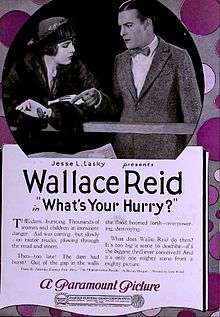What's Your Hurry?
What's Your Hurry? is a 1920 American silent drama film produced by Famous Players-Lasky and distributed by Paramount Pictures.[1] It was directed by Sam Wood and stars Wallace Reid and Lois Wilson. This film is preserved at Gosfilmofond in Moscow.[2][3][4]
| What's Your Hurry? | |
|---|---|
 Ad for film | |
| Directed by | Sam Wood |
| Produced by | Adolph Zukor Jesse Lasky |
| Written by | Byron Morgan (scenario) |
| Based on | The Hippoptamus Parade by Byron Morgan |
| Starring | Wallace Reid Lois Wilson |
| Cinematography | Alfred Gilks Osmond Borradaile (ass't camera) |
| Distributed by | Paramount Pictures |
Release date |
|
Running time | 5 reels; 5,040 feet |
| Country | United States |
| Language | Silent (English intertitles) |
Plot
As described in a film magazine,[5] to win the favor of his sweetheart's father "Old Pat" MacMurran (Ogle), race car driver Dusty Rhoades (Reid) forsakes the speedway in determination to put over effective publicity for the father's product, Pakro motor trucks. A prospective order from Cabrillo Irrigation Company is an incentive to his effort. MacMurran fumbles his publicity plan to bring a giant Christmas tree down from the mountains for the children of Los Angeles on a Pakro truck and goes soberly to the Cabrillo Valley to spend the holiday. Inability to get supplies to builders of the valley dam over the storm-driven roads threatens the lives and homes of valley residents. The day is saved by a truck driven by Dusty carrying the necessary supplies. There is a certainty of a wife for Dusty in Virginia MacMurran (Wilson) and a job at Pakro as the film ends.
Cast
- Wallace Reid as Dusty Rhoades
- Lois Wilson as Virginia MacMurran
- Charles Ogle as Patrick MacMurran
- Clarence Burton as Brenton Harding
- Ernest Butterworth as The Office Boy
- unbilled
- Ernest Joy
- Jack Young
See also
References
- The AFI Catalog of Feature Films: What's Your Hurry?
- Progressive Silent Film List: What's Your Hurry? at silentera.com
- The American Film Institute Catalog Feature Films: 1911-20 by The American Film Institute, 1988
- The Library of Congress American Silent Feature Film Survival Catalog: What's Your Hurry?
- "Reviews: What's Your Hurry?". Exhibitors Herald. New York City: Exhibitors Herald Company. 11 (8): 90. August 21, 1920.